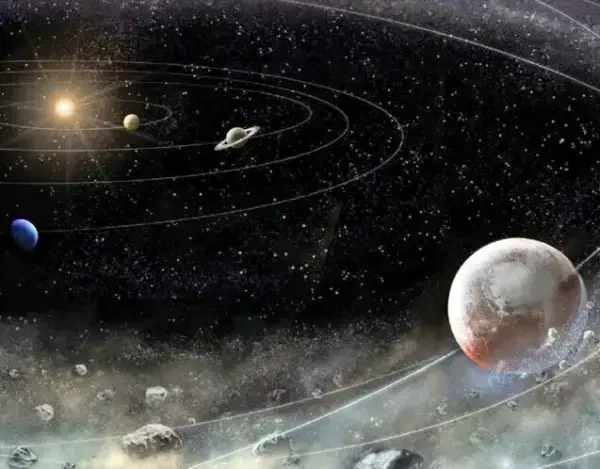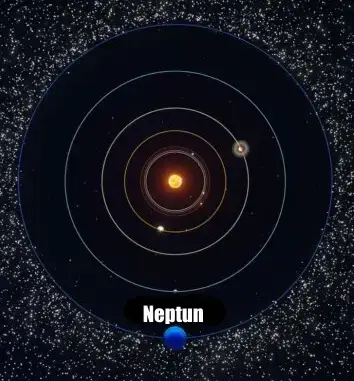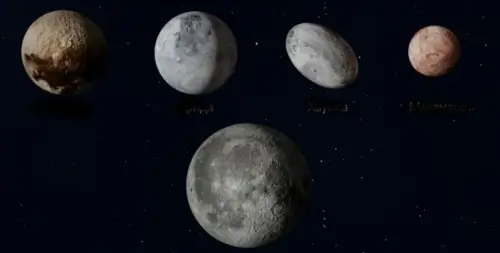Kuiper Belt. If our Solar System were a bustling metropolis, the inner planets, Mercury, Venus, Earth, and Mars would be its dense, rocky downtown.
The gas giants Jupiter, Saturn, Uranus, and Neptune would be the sprawling, chaotic suburbs. And beyond that? Beyond the last skyscraper of Neptune, where the light of our Sun fades to a pale glimmer, lies the true frontier.
This is the realm of the Kuiper Belt, the Solar System’s quiet, icy outskirts.
This is not just empty space. It is a vast, donut-shaped ring of primordial debris, a cosmic warehouse of antiquities where the building blocks of our system have been kept in a deep freeze for 4.6 billion years.
It is a place of perpetual twilight, populated by ghosts icy worlds we never knew existed until very recently. To journey here is to journey back to the dawn of time itself.
Kuiper Belt, Discovery of a New Realm.
For centuries, our map of the Solar System ended with Pluto, discovered in 1930. It was considered the lone, eccentric sentinel guarding the edge of explored space. But some astronomers suspected it wasn’t alone.
In 1943, Irish astronomer Kenneth Edgeworth proposed that beyond Neptune, there must be a vast reservoir of “comet-stuff,” the leftover material from the Solar System’s formation.
In 1951, the Dutch-American astronomer Gerard Kuiper refined the idea, theorizing that a belt of such objects should have formed, but he ironically concluded that the gravity of the giant planets would have scattered it all away by now.
History, it turns out, has a sense of irony. The region now famously bears Kuiper’s name, despite his doubts.
For decades, this “Kuiper Belt” remained pure theory. Searching for it was a monumental task, like trying to spot a single piece of dark gravel on a football field at night, using only a candle, from a mile away. The objects were predicted to be small, dark, and impossibly far.
Then, on August 30, 1992, astronomers David Jewitt and Jane Luu, after a grueling five-year search, found it. Using a powerful telescope at Mauna Kea, Hawaii, they detected a faint, slow-moving speck of light far beyond Neptune.
It was designated 1992 QB1. It was tiny, perhaps only 100 kilometers across, and staggeringly distant.
It was the breakthrough. 1992 QB1 was the first confirmed sighting of a “Kuiper Belt Object” (KBO). It proved that Pluto wasn’t an anomaly; it was simply the first (and largest) member of a vast, undiscovered population.
The floodgates had opened. In the years since, thousands of KBOs have been cataloged, and astronomers estimate there are hundreds of thousands larger than 100 km across, and likely trillions of smaller, comet-sized bodies. The “quiet outskirts” were suddenly looking very crowded.
Charting the Icy Abyss.
So, where is this frozen wilderness? The Kuiper Belt is an immense region. It begins just past the orbit of Neptune, at about 30 Astronomical Units (AU) from the Sun. (One AU is the distance from the Earth to the Sun, about 150 million kilometers or 93 million miles).
Neptune, at 30 AU, is already so far that it takes sunlight over four hours to reach it. The Kuiper Belt starts there and stretches outwards, with its main, dense concentration ending at around 50 AU.
To put this in perspective, the Voyager 1 spacecraft, traveling at over 38,000 miles per hour, took 35 years to reach this distance.
Despite containing billions or even trillions of objects, the Kuiper Belt is overwhelmingly empty space. The objects are spread so thin that if you were standing on one, you would likely be unable to see the next closest one with your naked eye. It would just be another faint “star” in the blackness.
The total mass of all this material is surprisingly low. Current estimates suggest the entire belt contains only about 2% to 10% of the mass of Earth. It’s a true giant made of dust and ice, spread incredibly thin.
The environment here is almost unimaginable. The Sun, which dominates our sky, would appear as little more than an intensely bright star, casting a dim, twilight glow but providing almost no heat. Temperatures hover near absolute zero, at around -220°C (-370°F). Here, common substances like water, methane, and nitrogen are frozen as hard as rock.
A Failed Planet, A Perfect Fossil.
How did this “ghostly” region come to be? The Kuiper Belt is a direct snapshot of the birth of our Solar System.
Billions of years ago, when our Sun was just a newborn star, it was surrounded by a massive, swirling disk of gas and dust called the protoplanetary disk.
In this chaotic construction zone, dust grains stuck together to form pebbles, pebbles formed boulders, and boulders collided to become “planetesimals”—the small, seedling worlds that would eventually grow into the planets we know today.
In the inner Solar System, it was warm enough for rock and metal to survive, forming the terrestrial planets. In the outer system, it was cold enough for ice to form, allowing the gas giants to grow massive by sweeping up huge amounts of hydrogen and helium gas.
The Kuiper Belt is the material that never got the chance to finish the job. It is a “failed planet,” or more accurately, the leftover building material that was stopped mid-construction. The primary culprit for this stunted growth was Neptune.
Astronomical models, particularly the “Nice model,” suggest that the giant planets didn’t form where they are today. They migrated. As Neptune, the outermost giant, drifted slowly outward, its immense gravity acted like a cosmic snowplow and a shepherd.
It flung countless icy planetesimals out of the system entirely, sending them into the deep-space reservoir we now call the Oort Cloud.
But it also “shepherded” and trapped many other objects into stable, resonant orbits, sculpting the region we see today. The Kuiper Belt is, in essence, the debris field left behind by Neptune’s great migration.
The Rogue’s Gallery.
Inhabitants of the Dark.
The Kuiper Belt is far from uniform. It is home to a diverse population of worlds, some of which have become household names.
• The Dwarf Planets: This region is the designated home of the dwarf planets. The most famous, of course, is Pluto. The New Horizons mission in 2015 revealed it to be a stunningly complex world, with vast, smooth plains of nitrogen ice (Sputnik Planitia), towering mountains of water ice, a thin blue atmosphere, and possible signs of a subsurface liquid water ocean.
Pluto is no longer a “planet,” but it is the undisputed “King of the Kuiper Belt.”
• Pluto is joined by its brethren. Eris, discovered in 2005, is slightly smaller than Pluto but more massive, and it was its discovery that forced the astronomical community to formally define the word “planet,” leading to Pluto’s reclassification. Haumea is a bizarre, egg-shaped world that spins so fast its “day” is only four hours long; this rapid spin has likely flung material off it to form its own tiny ring system.
Makemake is another large KBO, a bright, reddish world named after the creator god of the Rapa Nui people of Easter Island.
• The Moons and Binaries: Many KBOs have partners. Pluto’s largest moon, Charon, is so enormous—about half Pluto’s size—that the two are often called a “binary system.” They orbit a common point in space between them, locked in a perpetual dance.
Many other KBOs have been found to be binaries, which tells astronomers that the early Kuiper Belt was a “gentle” place, where objects could slowly drift together and pair up without shattering each other.
• The Colors of the Belt: One of the most curious features of KBOs is their color. They range from neutral grey/blue (like Haumea) to a distinct, rich red (like Makemake and many others).
Scientists believe this reddish color comes from tholins complex organic molecules that are created when cosmic rays and weak ultraviolet sunlight irradiate the frozen methane, nitrogen, and ammonia on their surfaces. These tholins are, essentially, the raw, chemical precursors to life.
The Source of Messengers.
The Kuiper Belt isn’t just a static museum. It actively sends messengers into the inner Solar System. These are the short-period comets.
While long-period comets (which take thousands of years to orbit) come from the distant Oort Cloud, the comets that visit us more frequently every few decades or centuries, like Halley’s Comet are believed to originate in the Kuiper Belt.
Every so often, a gravitational nudge perhaps from a passing KBO or the ever-present tug of Neptune will disrupt the stable orbit of one of these icy bodies. It’s sent falling inward, on a long journey toward the Sun.
As it gets closer, the Sun’s warmth begins to sublimate its ices (turn them directly from solid to gas). This gas, along with the dust it carries, erupts from the surface to form the glowing “coma” (the comet’s head) and the long, iconic tail.
Every glittering comet that streaks across our night sky is a pristine sample of the Kuiper Belt, a 4.6-billion-year-old snowball delivering clues about our own origins.
The Hunt for the Shadow.
Planet Nine.
Perhaps the most electrifying mystery of the Kuiper Belt emerged in 2016. Astronomers Konstantin Batygin and Mike Brown (the same astronomer who discovered Eris) noticed something strange.
A handful of the most distant KBOs objects on wild, elongated orbits all seemed to be aligned. Their orbits were all tilted in the same direction and pointed toward the same quadrant of the sky.
The odds of this happening by chance are incredibly low, like finding ten spinning coins that all land on their edge.
Batygin and Brown proposed a stunning solution: there is a ghost in the system. They hypothesize that a massive, unseen planet a “Planet Nine” is lurking in the extreme outer Solar System, acting as a cosmic puppet master. Its gravity, they calculate, is shepherding these smaller objects, forcing them into their strange, clustered orbits.
This isn’t a tiny world. Planet Nine is predicted to be a “super-Earth” or “mini-Neptune,” perhaps 5 to 10 times the mass of Earth. Its proposed orbit is vast, taking it 10,000 to 20,000 years to circle the Sun once.
At that distance, it would be impossibly faint and cold. The hunt is on, with powerful telescopes like the Subaru Telescope in Hawaii scanning the skies for this shadowy giant. If found, it would fundamentally change our map of the Solar System once again.
New Horizons.
Humanity’s Emissary.
We have sent only one envoy, one robotic ambassador, to this distant realm. Launched in 2006, NASA’s New Horizons spacecraft was the fastest machine ever built by humanity.
After a nine-and-a-half-year journey, it executed a flawless flyby of Pluto in July 2015, delivering the breathtaking images that transformed a fuzzy dot into a living, dynamic world.
But its mission wasn’t over. After Pluto, the spacecraft coasted deeper into the Kuiper Belt. On New Year’s Day 2019, it reached its next target: (486958) Arrokoth.
This was, and still is, the most distant object ever explored up close. Arrokoth was a revelation. It is a “contact binary,” formed from two separate, pancake-shaped lobes that gently bumped into each other and stuck together.
It looks like a lumpy, reddish snowman. Its pristine, unbattered shape is a perfect fossil, confirming that KBOs formed gently, through slow accretion, not violent collisions.
Today, New Horizons continues its journey, flying ever outward through the Kuiper Belt. It is still healthy and reporting back, its team on Earth using powerful telescopes to search for one more potential target to fly past before the spacecraft’s power finally fades. It is our silent messenger in the dark.
The Frozen Chronicle.
The Kuiper Belt is not a dead, empty wasteland. It is not just a dump for ancient ice. It is a dynamic, complex, and vital part of our Solar System. It is a chronicle, a book written in ice, detailing the first chapter of our home’s history.
Each of its fragments is a page from that book, preserved in the cold and dark. In the reddish tholins on their surfaces, we see the raw ingredients for life, scattered throughout the cosmos. In their gentle orbits, we see the echoes of planetary migration. In their mysterious alignments, we may see the shadow of a hidden giant.
The Kuiper Belt is the boundary of the known Solar System, but it is also the beginning of the great, unexplored dark. Who knows what other secrets are hidden there, waiting for our next messenger to fly by?
The key to understanding how our world and perhaps even how life itself came to be, may be locked in that frozen frontier.
Have a Great Day!




